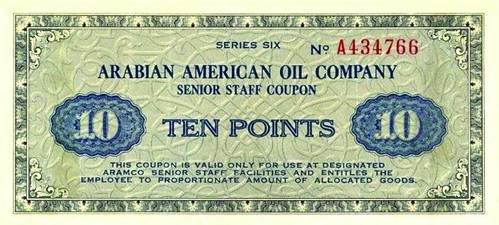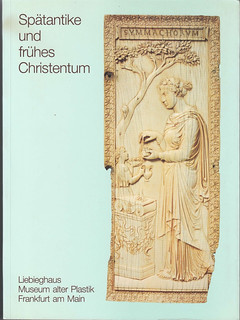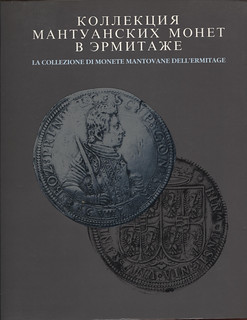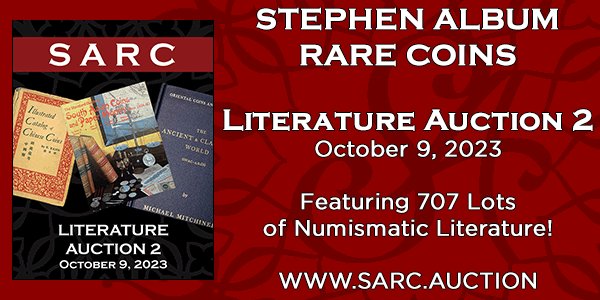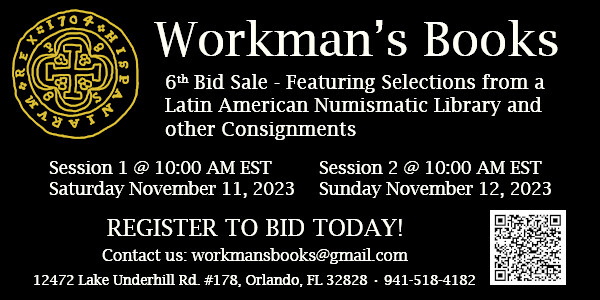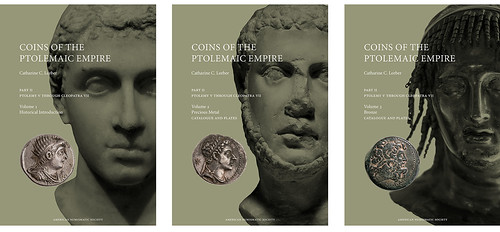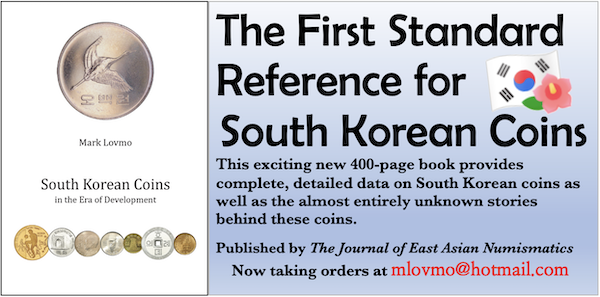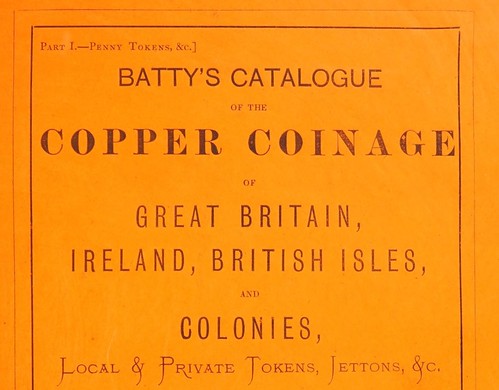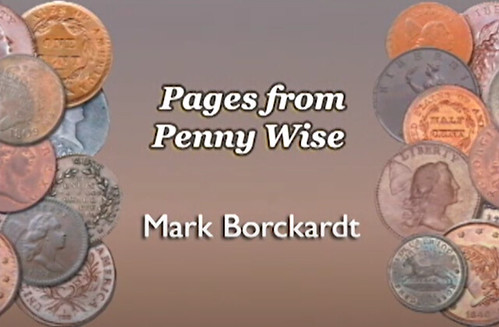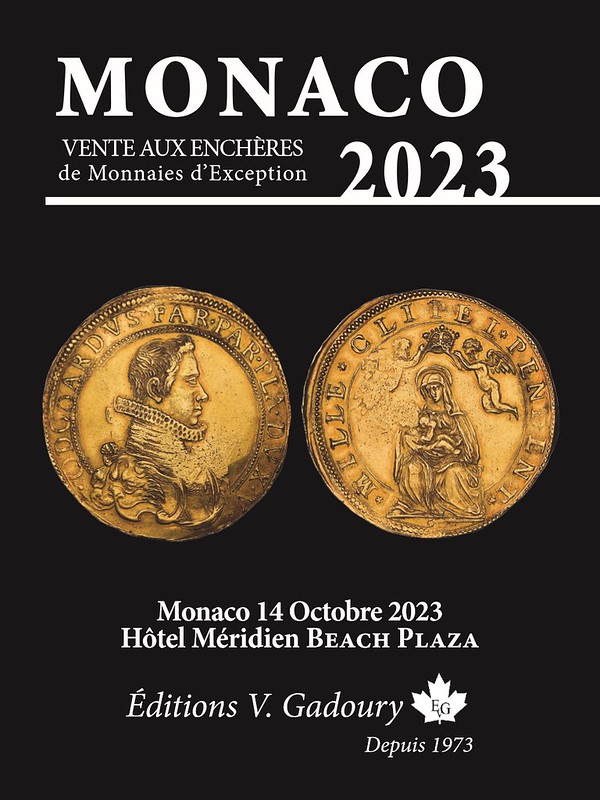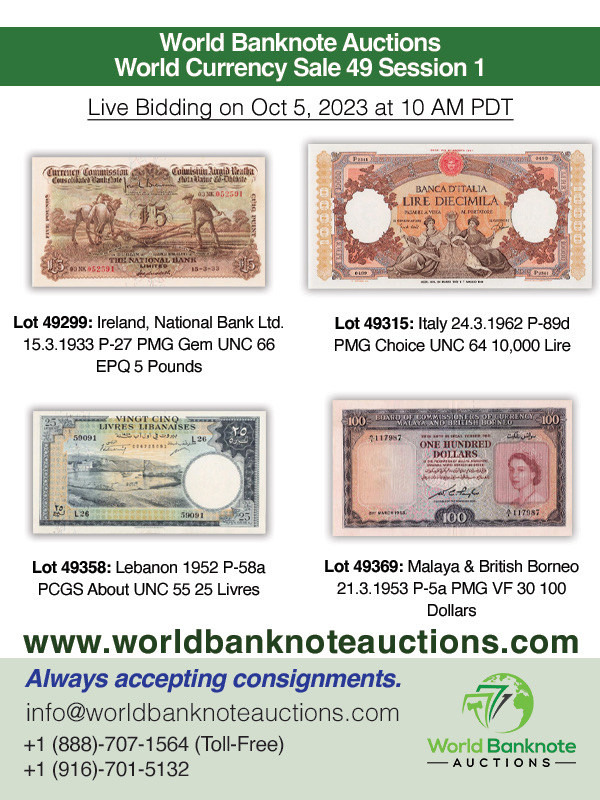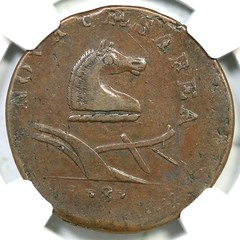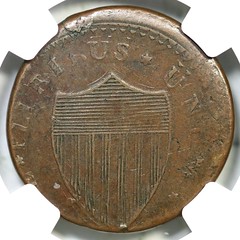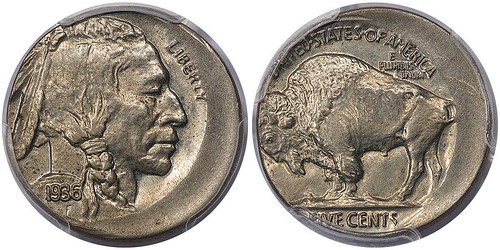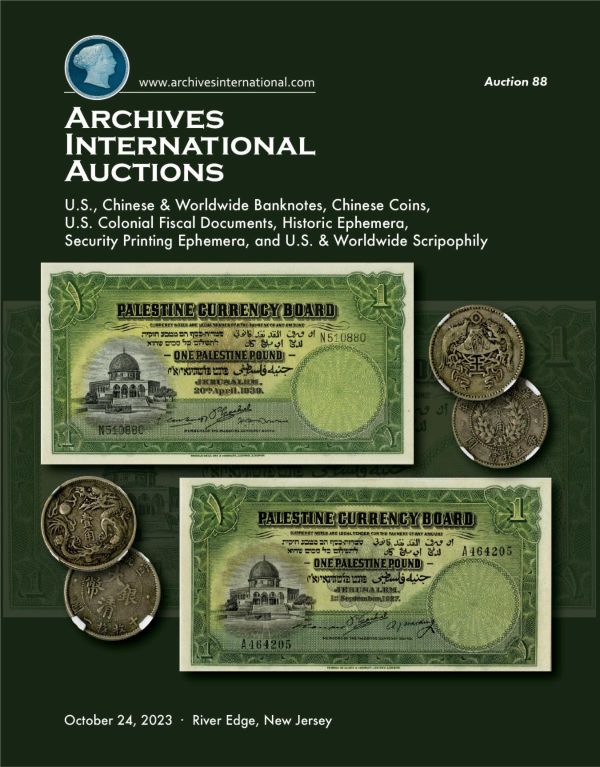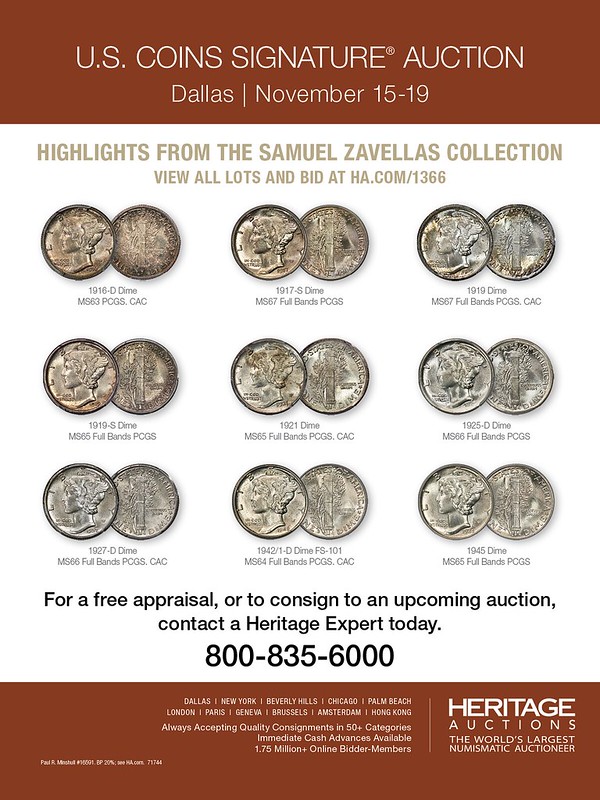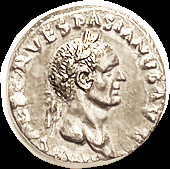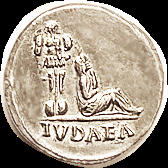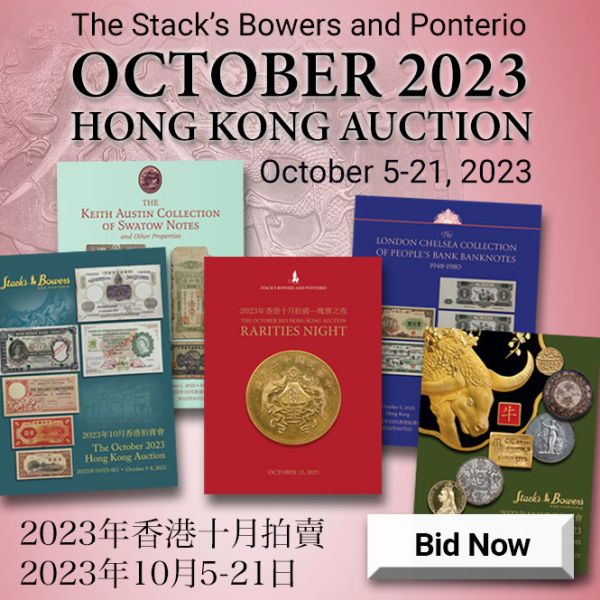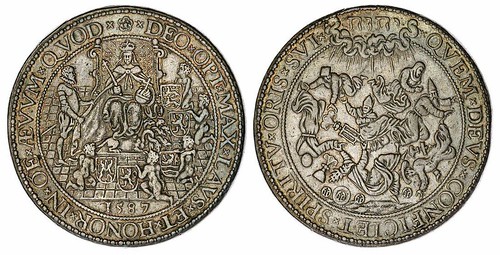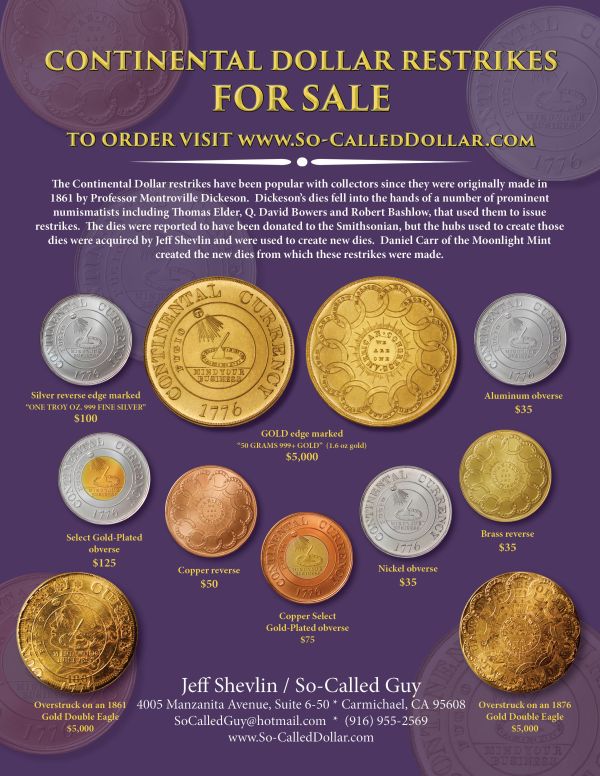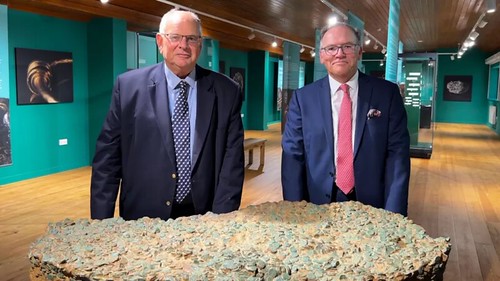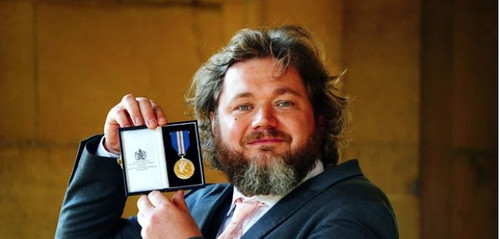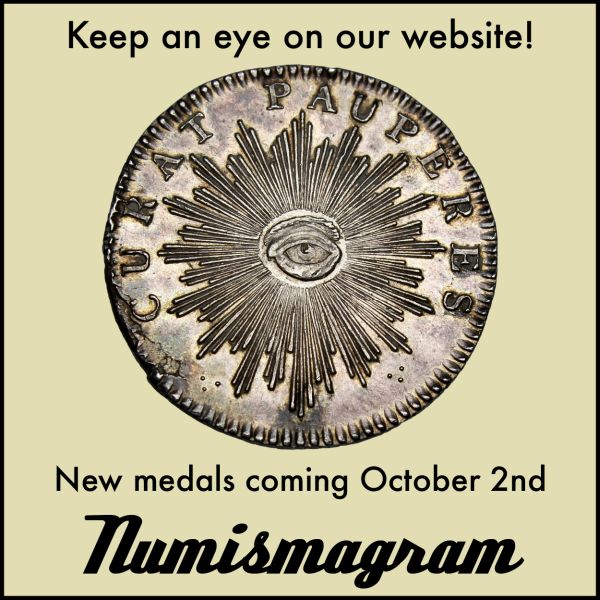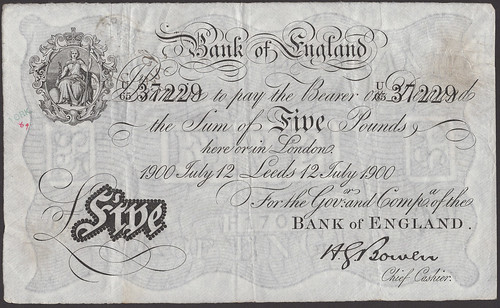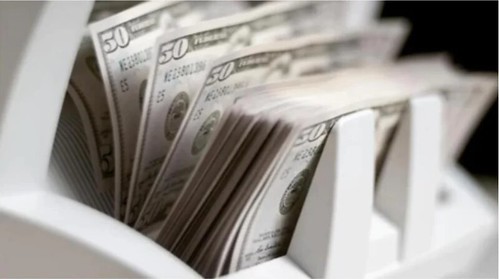
Visit our NBS Sponsors




About UsThe Numismatic Bibliomania Society is a non-profit association devoted to the study and enjoyment of numismatic literature. For more information please see our web site at coinbooks.org SubscriptionsThose wishing to become new E-Sylum subscribers (or wishing to Unsubscribe) can go to the following web page link MembershipThere is a membership application available on the web site Membership Application To join, print the application and return it with your check to the address printed on the application. Print/Digital membership is $40 to addresses in the U.S., and $60 elsewhere. A digital-only membership is available for $25. For those without web access, write to: Jeff Dickerson, Treasurer AsylumFor Asylum mailing address changes and other membership questions, contact Jeff at this email address: treasurer@coinbooks.org SubmissionsTo submit items for publication in The E-Sylum, write to the Editor at this address: whomren@gmail.com BUY THE BOOK BEFORE THE COIN |
- WAYNE'S WORDS: THE E-SYLUM OCTOBER 1, 2023
- APHRODITE AUCTION 14 LITERATURE SELECTIONS
- NEW BOOK: COINS OF THE PTOLEMAIC EMPIRE, PART 2
- NEW BOOK: BRITISH CELTIC COINS
- NEW BOOK: MORGAN AND PEACE DOLLARS 5TH ED
- NEW BOOK: THE GERMAN BANKNOTES, 23RD ED
- BOOK REVIEW: SAFEGUARDING HISTORY
- ANA LIBRARY ADDS FIRST EDITION VAN LOON
- NNP ADDS BATTY'S COPPER COINAGE
- VIDEO: MARK BORCKARDT AND PENNY WISE
- HARVARD MUSICAL CLUBS
- NOTES FROM E-SYLUM READERS: OCTOBER 1, 2023
- RESEARCHING NEW JERSEY COPPERS
- 2023 DEREK ALLEN PRIZE WINNER JOE CRIBB
- VOCABULARY TERM: OFF CENTER
- WILLIAM HENRY RUE (1911-1972)
- MORE ON THE FRANK S. ROBINSON SALE 122
- MDC OCTOBER 2023 FRENCH COLLECTION SELECTIONS
- NUMISMATIC NUGGETS: OCTOBER 1, 2023
- COINS OF THE FALL OF ROME
- JERSEY COIN HOARD RESEARCH MONEY ALLOCATED
- LONDON BRIDGE HERO RECIEVES QUEEN'S MEDAL
- NOONAN'S OFFERS RARE BANK OF ENGLAND NOTES
- ARAMCO COUPONS
- PENNY PEEVE
- COLLECTING NAZI MEMORABILIA
- THE LEGEND OF NEW YORK'S HELL GATE TREASURE
- LOOSE CHANGE: OCTOBER 1, 2023
- WOMAN CAUGHT SMUGGLING GOLD COINS
- FEATURED WEBSITE: CARNATION, LLC
Content presented in The E-Sylum is not necessarily researched or independently fact-checked, and views expressed do not necessarily represent those of the Numismatic Bibliomania Society.
WAYNE'S WORDS: THE E-SYLUM OCTOBER 1, 2023
 Thank you for reading The E-Sylum. If you enjoy it, please send me the email addresses of friends you think may enjoy it as well and I'll send them a subscription. Contact me at whomren@gmail.com anytime regarding your subscription, or questions, comments or suggestions about our content.
Thank you for reading The E-Sylum. If you enjoy it, please send me the email addresses of friends you think may enjoy it as well and I'll send them a subscription. Contact me at whomren@gmail.com anytime regarding your subscription, or questions, comments or suggestions about our content.
This week we open with a numismatic literature sale, four new books, a book review, ANA Library news, updates from the Newman Numismatic Portal, and more.
Other topics this week include Harvard Musical Clubs, New Jersey coppers, Joe Cribb, auction previews, off-center coins, rare Bank of England notes, Aramco coupons, and New York's Hell Gate treasure.
To learn more about coins of the Ptolemaic Empire, British Celtic coins, Morgan and Peace Dollars, Ken Rendell, Gerard Van Loon, Jim Groninger, Dale Seppa, Catherine Bullowa, Batty's Copper Coinage, the Protestants Supported Medal, ventriloquist Joseph Askins, the Queen's Medal for Gallantry, and the coin collection of Sir Arthur Conan Doyle, read on. Have a great week, everyone!
Wayne Homren
Editor, The E-Sylum
APHRODITE AUCTION 14 LITERATURE SELECTIONS
Andrew Pollack alerted me to the books and auction catalog section of the upcoming sale by Aphrodite of Germany. The literature sections close October 2. Thank you. Here are some selected lots. -Editor
Lot 1717: AA.VV. Spatantike und fruhes Christentum. Frankfurt, 1984 Legatura editoriale, pp. 698, ill.
NEW BOOK: COINS OF THE PTOLEMAIC EMPIRE, PART 2
The American Numismatic Society has published the long-awaited three-volume follow-up to Coins of the Ptolemaic Empire by Catharine C. Lorber. The books are being printed and pre-orders are now being accepted. -Editor
Coins of the Ptolemaic Empire, Part 2: Ptolemy V through Cleopatra VII (3 vols.)
Coins of the Ptolemaic Empire, Part II, by Catharine C. Lorber, is the long-anticipated second half of the Coins of the Ptolemaic Empire (CPE) project featuring the coins struck by Ptolemy V–Cleopatra VII. As with Part 1, Lorber essentially rewrites the sections on these rulers in J. N. Svoronos' classic, but now much out-of-date, Ta Nomismata tou Kratous ton Ptolemaion (1904). The body of coinage catalogued by Svoronos is enlarged by hundreds of additional emissions in precious metal and bronze, recorded from subsequent scholarship, from hoards, from commercial sources, and from private collections. Lorber's attributions, dates, and interpretations rest on numismatic research conducted after Svoronos, or on the latest archaeological and hoard information. She also provides extensive historical and numismatic introductions that give the coins deeper context and meaning. Available as a 3-volume set with extensive historical introductions, catalogues, and plates for precious metal and bronze coinage.
NEW BOOK: BRITISH CELTIC COINS
SPINK has published a new book by Tim Wright on British Celtic coins. -Editor
British Celtic Coins: Art or Imitation?
Tim Wright
£30.00
 The peoples of pre-Roman Britain remain an enigma. Our perceptions are shaped by two narratives, that of contemporary Roman colonists and more recent Celtic nationalists, who vilify and glorify them in equal measure. The more we learn, the less we know with certainty: should they be described as ‘Celtic peoples', were they organised into the ‘tribes' that later formed Roman administrative districts (civitas) and, beyond a few famous names like Cunobelinus (Shakespeare's Cymbeline), were they led by ‘kings' or ‘chieftains'?
The peoples of pre-Roman Britain remain an enigma. Our perceptions are shaped by two narratives, that of contemporary Roman colonists and more recent Celtic nationalists, who vilify and glorify them in equal measure. The more we learn, the less we know with certainty: should they be described as ‘Celtic peoples', were they organised into the ‘tribes' that later formed Roman administrative districts (civitas) and, beyond a few famous names like Cunobelinus (Shakespeare's Cymbeline), were they led by ‘kings' or ‘chieftains'?
The coins from this period are no less controversial. Britain was a late adopter of coinage, initially importing coins from the Gallo-Belgic continent and then copying their Macedonian-inspired prototypes. Britain also produced them for longer than the continent, latterly incorporating themes and imagery from Rome. These bookends of external influence have led some to dismiss the coins of pre-Roman Britain (and indeed ‘Celtic' coins generally) as inferior. The most compelling counter to this is the coins themselves, explored through the theme of Art or Imitation? What we find is extraordinary variety and originality, that makes a powerful case for their collection and study.
NEW BOOK: MORGAN AND PEACE DOLLARS 5TH ED
A new 5th edition of the Comprehensive Catalog and Encyclopedia of Morgan and Peace Dollars is now available. Here's the announcement. -Editor
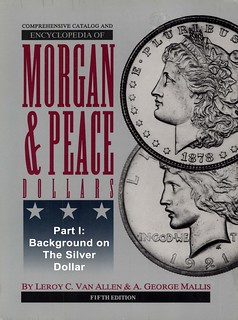 This is to announce parts I, II and III of the 5th Edition of the Comprehensive Catalog and Encyclopedia of Morgan and Peace Dollars is now available on Amazon Kindle. It was edited by Michael S. Fey, Ph.D. and provides references and links to annual supplemental discoveries, and so much more.
This is to announce parts I, II and III of the 5th Edition of the Comprehensive Catalog and Encyclopedia of Morgan and Peace Dollars is now available on Amazon Kindle. It was edited by Michael S. Fey, Ph.D. and provides references and links to annual supplemental discoveries, and so much more.
This landmark reference includes information on availability, populations, grading, history, design development, errors, varieties, Government Services Administration (GSA) and Redfield hoards, preservation, storage, photography and counterfeiting of Morgan and Peace silver dollars. Each part is priced at only $9.95. Now, instead of carrying around this heavy reference work, any dealer, collector, investor or interested party can carry it on their phone or on their home computer.
This now opens, for the first time to the general public, inexpensive and detailed information from Leroy Van Allen and A. George Mallis of just about everything you might want to know about Morgan and Peace silver dollars. It also brings this vital information into the digital age and into the future where it can potentially engage hundreds of thousands of U.S. Mint buyers as well as serious collectors.
THE BOOK BAZARRE
NEW BOOK: THE GERMAN BANKNOTES, 23RD ED
There's a new edition of the book on German banknotes by Hans-Ludwig Grabowski. Here's a Google-translated description from the publisher's website. -Editor
The German banknotes from 1871
Hans Ludwig Grabowski
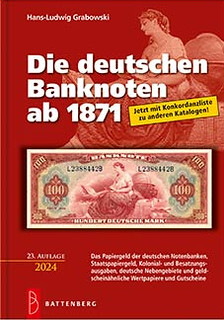 The paper money of the German central banks, government paper money, colonial and occupation issues, German tributaries and banknote-like securities and vouchers
The paper money of the German central banks, government paper money, colonial and occupation issues, German tributaries and banknote-like securities and vouchers
ISBN: 978-3-86646-224-3
Edition: 23rd edition 2023/2024
Dimensions: 14.8 x 21 cm
Type of figures: colored throughout
Type of cover: Hardcover
Number of pages: approx. 864
The completely colored, current standard work on German banknotes from the founding of the German Empire in 1871 to the present day of the Euro, divided into historical eras: Empire, Weimar Republic
, Third Reich
, Allied Occupation, GDR, Federal Republic and subsidiary regions. In addition to the notes of the German central banks (including the state central banks), government paper money, colonial and occupation expenditure, banknote-like securities and vouchers as well as occupation expenditure from both world wars and military money were included. All areas are cataloged with their own number ranges and are currently assessed.
BOOK REVIEW: SAFEGUARDING HISTORY
Here's another review of Ken Rendell's memoir, Safeguarding History, this time my historian Doris Kearns Goodwin. -Editor
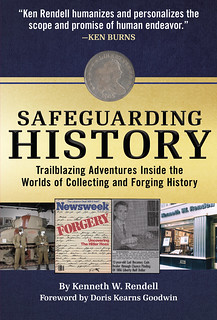 Whitman Publishing will release Safeguarding History, the memoirs of internationally famous artifacts collector and dealer Kenneth W. Rendell. Subtitled Trailblazing Adventures Inside the Worlds of Collecting and Forging History, the 328-page book shares Rendell's business philosophy as well as his life story, and shows why he's known as the
Whitman Publishing will release Safeguarding History, the memoirs of internationally famous artifacts collector and dealer Kenneth W. Rendell. Subtitled Trailblazing Adventures Inside the Worlds of Collecting and Forging History, the 328-page book shares Rendell's business philosophy as well as his life story, and shows why he's known as the Indiana Jones
of the collecting world.
Among coin collectors, Rendell is noted as a founding member of the Rittenhouse Society, a contemporary of Q. David Bowers and Kenneth Bressett. He was a prodigy coin dealer while in his teens in the 1950s, selling colonial coppers to such luminaries as Ambassador R. Henry Norweb, and a contributor to the Red Book at the age of sixteen.
Pulitzer Prize–winning historian Doris Kearns Goodwin wrote the foreword to Safeguarding History. Here, she shares her thoughts on Kenneth Rendell and his autobiography:
ANA LIBRARY ADDS FIRST EDITION VAN LOON
The ANA library has acquired a copy of the classic Van Loon work on Dutch medals. -Editor
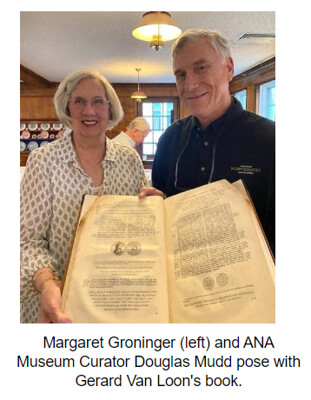 The American Numismatic Association (ANA) Dwight N. Manley Library is the world's largest numismatic lending library. It is host to more than 128,000 books, auction catalogs, periodicals, DVDs and more. Another addition was made to the library during the ANA President's Reception, which took place during the World's Fair of Money® in Pittsburgh. During the event, Margaret Groninger donated her late-husband James G. Groninger's set of Gerard Van Loon's "Beschryving der Nederlandsche Historipenningen" to the ANA library.
The American Numismatic Association (ANA) Dwight N. Manley Library is the world's largest numismatic lending library. It is host to more than 128,000 books, auction catalogs, periodicals, DVDs and more. Another addition was made to the library during the ANA President's Reception, which took place during the World's Fair of Money® in Pittsburgh. During the event, Margaret Groninger donated her late-husband James G. Groninger's set of Gerard Van Loon's "Beschryving der Nederlandsche Historipenningen" to the ANA library.
Although published in the first half of the 18th century, the first edition of this four volume reference remains a standard for researchers and collectors of Dutch medals. This set covers commemorative medals produced by The Netherlands during the period of 1555 through 1716 and includes a written description of each medal, engraved images, and commentary by Van Loon. Also included with this donation is an English translation of the Dutch text by Robert Turfboer.
NNP ADDS BATTY'S COPPER COINAGE
The latest addition to the Newman Numismatic Portal is Batty's Catalogue of the Copper Coinage of Great Britain, Ireland, British Isles and Colonies. Project Coordinator Len Augsburger provided the following report. -Editor
Newman Portal Scans D. T. Batty's Catalogue of Copper Coinage
Recently scanned at the American Numismatic Society is Batty's Catalogue of the Copper Coinage of Great Britain, Ireland, British Isles and Colonies. This four-volume work was originally issued in parts, between 1868 and 1898. The October 1876 American Journal of Numismatics reported Mr. D. T. Batty…is now publishing a valuable work…It is compiled from various sources, but especially from the author's own collection of fifteen thousand varieties…
VIDEO: MARK BORCKARDT AND PENNY WISE
The David Lisot Video Library on the Newman Numismatic Portal can be found at:
https://nnp.wustl.edu/library/multimediadetail/522852
We highlight one of his videos each week in The E-Sylum. Here's one from 2007 with Mark Borckardt speaking about his large cent research in the pages of Penny Wise. -Editor
HARVARD MUSICAL CLUBS
Jonathan Brecher submitted these notes and images on Harvard Banjo Club medals. Thank you! For reference I've pictured Dave Schenkman's piece at the top of the article - the others are Jonathan's. -Editor
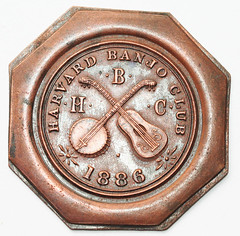 I have a Harvard Banjo Club piece similar to Dave Schenkman's example. Rulau cites the Kirtley sale in calling it a splasher. I don't think that's the right term. I also don't think I'd call it a die trial. On the other hand I'm not comfortable calling it a finished piece either. If you look at Dave's piece, the edges are irregularly trimmed. They are irregular on my pieces as well — but differently irregular. That speaks to me as not a finished production, whatever term you want to apply to these pieces.
I have a Harvard Banjo Club piece similar to Dave Schenkman's example. Rulau cites the Kirtley sale in calling it a splasher. I don't think that's the right term. I also don't think I'd call it a die trial. On the other hand I'm not comfortable calling it a finished piece either. If you look at Dave's piece, the edges are irregularly trimmed. They are irregular on my pieces as well — but differently irregular. That speaks to me as not a finished production, whatever term you want to apply to these pieces.
Anne Bentley's article on Harvard medals in the September 2020 MCA Advisory has a photo of a different Harvard Banjo Club medal that is silver plated and with a different design.
I purchased my example with several other uniface Harvard medals for the Harvard Advocate, the Harvard Mandolin Club, and the Harvard Musical Club. The Harvard Musical Club medal does exist with a struck reverse (Storer 906), which supports the idea that these are not finished pieces. There are other struck medals for The Harvard Advocate (Storer 878-879), but this one is from a different die than any other example I could find (this one has a smaller Pegasus). I haven't found struck examples of Harvard Banjo Club or Harvard Mandolin Club medals.
NOTES FROM E-SYLUM READERS: OCTOBER 1, 2023
On Originals vs Copies
Earlier Pete Smith asked, "Is a typewritten original letter worth any more than a letter printed with multiple copies or a photocopy?"
Dave Steine writes:
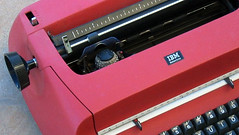
"For me, original handwritten or typed letters are much more valuable than copies. I especially like letters on original letterhead."
Me, too. I was never classy enough to get myself a letterhead. My physical correspondence was printed on plain printer paper. Now my correspondence is pretty much digital only. -Editor
To read the earlier E-Sylum article, see:
ORIGINALS, COPIES, AND TYPEWRITTEN LETTERS
(https://www.coinbooks.org/v26/esylum_v26n38a17.html)
Other topics this week include Digitizing Literature of Ancient Numismatics, Damaged Cash in the Philippines, and the Coin Collection of Sir Arthur Conan Doyle. -Editor
RESEARCHING NEW JERSEY COPPERS
Jeff Burke submitted this article on his careful research while acquiring a nice New Jersey copper for his collection. Thank you! -Editor
Researching My 1787 Maris 38-c New Jersey Colonial Copper Coin
It was my lucky night! New Jersey Numismatic Society members Bill Liatys and Michael Brooks surprised me by bringing an assortment of 40 to 50 raw and slabbed colonials to our April 2023 NJNS meeting for me to examine, ranging in grades from About Good to Mint State. It was the first time I had held a number of these specimens in my own hands since reading about them in the Red Book. They included colonials from VT, MA, CT, NY, NJ, and VA, as well as Rosa Americana 2 Pence and Half Pence, Machin's Mills, Mott Store Cards, Hibernia-Voce Populi coins, Talbot Allum & Lee examples, Nova Constellatio coppers, Woods Hibernia, Kentucky tokens, a Franklin Press Token, Washington pieces, North American tokens, and Bill's prized London Elephant token. It was fascinating to examine these specimens with my magnifying glass!
2023 DEREK ALLEN PRIZE WINNER JOE CRIBB
The Derek Allen Prize is awarded annually by the British Academy in recognition of outstanding work by a scholar in musicology, numismatics, and Celtic studies, in rotation. This was a numismatic year, and the winner was author and researcher Joe Cribb. Congratulations! -Editor
History of the prize
The award commemorates Derek Fortrose Allen (1910–1975), elected a Fellow in 1963, who served from 1969 to 1973 as Secretary of the Academy and from then until his death as Treasurer. It was founded in 1976 by his widow, Mrs Winifred Allen, and her sons to provide an award in one of three academic fields in which Mr Allen had particular interest. The prize was first awarded in 1977.
THE BOOK BAZARRE
VOCABULARY TERM: OFF CENTER
Here's another entry from Dick Johnson's Encyclopedia of Coin and Medal Terminology. I added some images from earlier E-Sylum articles. -Editor
Off Center. A striking error in which a blank does not fully enter into coining position and is struck only partially on its surface. In general off center coins are struck outside the collar, usually distorting the precise circle of the blank, with proper congruent obverse and reverse designs but leaving unstruck a crescent shaped area on the blank.
Off center coins are an anomaly of the feeding mechanism. It is the responsibility of this mechanism to pick up a single blank from the feeder tube and deliver this to a position above the collar, where the blank falls by gravity into coining position within the collar. When, for any reason, this does not happen the dies will create these partial strikes.
WILLIAM HENRY RUE (1911-1972)
E-Sylum Feature Writer and American Numismatic Biographies author Pete Smith submitted this article on an Ohio coin collector's murder. A fascinating, sordid and sobering account. Thank you. -Editor
William Rue was an eccentric Ohio coin collector. His teenage grandson became interested in his collection. Warning: This story does not have a happy ending.
William Henry Rue was born in Darke County, Ohio, in 1911. He lived in Darke county and the city of Bradford all his life. His father was a German immigrant and farmer, John Rue, and mother was Iva Cassen Rue.
William married Dorthea Overla on December 30, 1933. They would have six daughters, two sons and a 1953 divorce.
Rue was a forklift driver for Hobart Manufacturing Co. He was also an agent for the Greenville Advocate and the Dayton Daily Sunday News. Rue was an active member of the Miami County Coin Club but not a member of the ANA.
MORE ON THE FRANK S. ROBINSON SALE 122
NOTE: Frank Robinson's next sale is on October 9, 2023, not the 3rd as noted last week. Here are some additional selected lots.
The sale will include 596 lots of ancient and early world coins, low minimum bids, and bids to be reduced as competition permits. It includes a section of Judaic related coins, some very good British, early Chinese, a new section of Russian plus many group lots, and literature. -Editor
Lot 138 Vespasian, Den, IVDAEA, Jewess std r, beside trophy; EF, well centered, lgnds nrly complete albeit partly crude; excellent portrait of unusually fine style for this; rev exceptionally well detailed; ltly toned. Possibly a hint of smoothing, mentioned only in an excess of conscientiousness.
MDC OCTOBER 2023 FRENCH COLLECTION SELECTIONS
Here are some more selections from The French Collection offered in this month's MDC Monaco Auction No. 12. -Editor
presented by MDC Monnaises de Collection
Auction October 11, 2023
MDC Monnaies de collection is excited to auction The French Collection
in October 2023.
The collection of 540 lots, built over 40 years, includes the most beautiful coins from the
French Revolution to the Fifth Republic, with a vast majority of Top Pop. Today, it is not
possible to recreate such a collection. We know that many collectors will find in it the special
coins they have been looking for. The auction will take place in Monaco at the Hôtel Métropole on the 11th of October 2023, from 1:30 pm to 4 pm (lots 1 to 296) and from 4:15
pm to 7 pm (lots 297 to 540), Nicolas Gimbert, Auctioneer.
To view the complete collection:
https://mdc.mc/auction/vente-aux-encheres-numismatique-12/
NUMISMATIC NUGGETS: OCTOBER 1, 2023
Here's a selection of interesting or unusual items I came across in the marketplace this week. Tell us what you think of some of these. -Editor
1587 Protestants Supported Medal
Protestants Supported in the United Provinces, AR Medal, 1587, by Gerhard van Bijlaer, DEO OPT MAX LAVS ET HONOR IN OE ÆVVM QVOD (m.m rose), saltire stops, Elizabeth enthroned, attended by her courtier, the Earl of Leicester, as she tramples on a hydra, five naked figures kneel before a shield representing the provinces, 1587 in exergue, rev. QVEM DEVS CONFICIET SPIRITV ORIS SVI, saltire stops, popes, bishops and other religious figures fall from celestial clouds, 53mm, 45.11g, 12h (MI i 139/99; van Loon I, 369; Eimer 53), struck on a slightly concave flan, once lightly cleaned and now retoned, very fine, scarce
From the Spink COINEX Auction. -Editor
To read the complete lot description, see:
PROTESTANTS SUPPORTED IN THE UNITED PROVINCES, AR MEDAL, 1587, BY GERHARD VAN BIJLAER, DEO OPT...
(https://live.spink.com/lots/view/4-B5RKYN/protestants-supported-in-the-united-provinces-ar-medal-1587-by-gerhard-van-bijlaer-deo-opt)
Other topics this week include an 1796 Ventriloquist Token, the New York and Harlaem Railroad Token, and Civil War Scrip Payable in Confederate Notes. -Editor
COINS OF THE FALL OF ROME
Mike Markowitz published an articles in his CoinWeek Ancient Coin Series on "Shadow Emperors: Coins of the Fall of Rome." Here's an excerpt - see the complete article online. -Editor
THE ROMAN EMPIRE in the West died not with a bang, but with a whimper. A series of short-lived rulers, mostly puppets of barbarian warlords, presided over the accelerating collapse of a state that had endured for five glorious centuries. The coins issued in the names of these so-called Shadow Emperors
help to illustrate this dramatic and melancholy story.
JERSEY COIN HOARD RESEARCH MONEY ALLOCATED
Money has been allocated for further research on the massive coin hoard found on Jersey in 2021. -Editor
Chairman of the Highlands Foundation, David Lord and His Majesty's Receiver General for Jersey, Alan Blair at the display of the hoard at Le Hougue Bie
Ringfenced money from the largest iron age coin hoard in Jersey's history has been allocated to a foundation for science and research.
The Le Catillon II hoard was uncovered by two local amateur metal detectorists in 2012.
The Government of Jersey bought the hoard for £4.25m in 2021 after negotiations with the Crown, which claimed the discovery as a treasure trove in accordance with Jersey customary law.
LONDON BRIDGE HERO RECIEVES QUEEN'S MEDAL
The Polish worker who fought the London Bridge terrorist in 2019 has been awarded the Queen's Medal for Gallantry. Amazing story. -Editor
A Polish hero who used a ceremonial pike to fight off a terrorist on London Bridge in 2019 has been awarded the Queen's medal for bravery.
In a ceremony at Windsor Castle, Princess Anne presented Lukasz Koczocik with the Queen's Medal for Gallantry, which recognises exemplary acts of courage.
NOONAN'S OFFERS RARE BANK OF ENGLAND NOTES
Here's the press releases for the Thursday, October 12, 2023 Noonan's sale of some rare Bank of England notes. -Editor
An exceptionally rare Bank of England £5 note that was issued in Leeds is expected to fetch £12,000-£16,000 when offered in a sale of British and Irish Banknotes at Noonans on Thursday, October 12, 2023. Dated July 12, 1900, it is signed by Horace G. Bowen who was Chief Cashier at the Bank of England from 1893 to 1902.
As Andrew Pattison, Head of Banknote Department at Noonans commented: This is a great
note. Very few Bowen notes are in private hands especially from this exceptionally rare Leeds
branch. The York hand stamp shows part of the journey of the note, issued in Leeds and paid
into a bank at some point in York.
ARAMCO COUPONS
Thanks to their listing in the Red Book and Roger Burdette's new book, we're all aware of the Saudi gold discs. But I was unaware of the Arabian American Oil Company (Aramco) coupons, which circulated as currency for a time. Here's a short article mentioning them. Have these been published or catalogued elsewhere? -Editor
Saudi Arabia's founder King Abdulaziz bin Abdulrahman ordered in 1950 the minting of the Saudi guinea, kickstarting the development of the Kingdom's national currency.
The minting of the guinea was linked to the formation of the Aramco oil company and the aftermath of World War II.
Aramco employees were initially paid their wages in the form of ten pounds of silver, or 4.5 kgs. In 1932, the company issued paper currency known at the time as Aramco coupons.
PENNY PEEVE
This week's potential shutdown of the U.S. government gave opinion writers another opportunity to air their pet peeves, and since Dick Johnson isn't here to point this one out, I'll do it for him. An article in the Chicago Sun Times laments the continued production of the U.S. cent. -Editor
It costs 2 cents for the United States Mint to manufacture a Lincoln cent. In 2021, the government struck 7.1 billion of them. Two-thirds never circulate. They clutter up banks. Yet we keep minting them.
Whenever the nation's greatness
is bandied about, by those who imagine greatness is a quality that can be self-assigned, a little voice says, Yeah, we can't even get rid of the penny.
Australia managed. In 1990. Canada, too — a decade ago. Also Brazil, Finland, New Zealand, Norway, Israel — quite a list. Are they greater
than we are? Certainly pennywise.
COLLECTING NAZI MEMORABILIA
In the collectors-gonna-collect department, a Friday New York Times opinion piece asks, "What Kind of Person Has a Closet Full of Nazi Memorabilia?" We all know one kind - the collector. Here's a spotty excerpt, which can't do justice to the complete article available online. -Editor
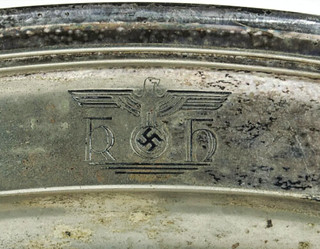 At the Ohio Valley Military Society's annual Show of Shows, there is plenty for sale that isn't Nazi memorabilia. All sorts of mementos from all sorts of wars: Civil War caps, antique pistols, Purple Hearts, samurai swords, World War I trench kits. But there is a lot of Nazi memorabilia.
At the Ohio Valley Military Society's annual Show of Shows, there is plenty for sale that isn't Nazi memorabilia. All sorts of mementos from all sorts of wars: Civil War caps, antique pistols, Purple Hearts, samurai swords, World War I trench kits. But there is a lot of Nazi memorabilia.
For a while I shadowed a tall, affable dealer from Belgium who specialized in badges and who'd already spent nearly all of the $100,000 in cash he'd brought with him. He stopped at one table and efficiently inspected a couple of dozen Nazi-era Iron Crosses, whispering to me which were fake or had been modified, before settling on one he liked, or at least thought worth the $500 he paid for it.
THE LEGEND OF NEW YORK'S HELL GATE TREASURE
Larry Edwards passed along this Atlas Obscura article about New York's legendary Hell Gate Treasure - the 1780 wreck of the HMS Hussar, rumored to be carrying the payroll of British troops in gold coins. Thanks! -Editor
Just off the coast of Astoria, Queens, at the confluence of the Harlem and East Rivers, is a narrow tidal channel. Hell Gate. Its fast currents change multiple times a day and it used to be riddled with rocks just beneath the surface.
Hell Gate is the final resting place of literally hundreds of ships. Most of them are forgotten but one continues to captivate. Because down there, under the minor maelstroms, is the promise of gold.
You're talking about centuries of navigation,
says Bronx Borough Historian Lloyd Ultan. Everything from rowboats to large ships have been sunk by hitting those rocks. One on top of the other on top of the other on top of the other.
LOOSE CHANGE: OCTOBER 1, 2023
Here are some additional items in the media this week that may be of interest. -Editor
The mainstream press can get an awful lot wrong about numismatics, but one area where they shine is profiling coin designers and subjects, bringing new perspectives not always found in the numismatic world. This item from the Christian Post discusses the subject of the Jovita Idar quarter as a Methodist social reformer. -Editor
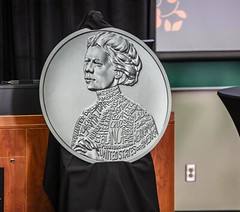 The U.S. Mint has released a quarter celebrating the life and accomplishments of Jovita Idar, a Mexican-American journalist and Methodist social reformer.
The U.S. Mint has released a quarter celebrating the life and accomplishments of Jovita Idar, a Mexican-American journalist and Methodist social reformer.
The Mint held two ceremonies earlier this month to celebrate the release of the Idar quarter, one on Sept. 14 with the National Women's History Museum and another on Sept. 16 with the Smithsonian American Women's History Museum and the Mexican American Civil Rights Institute.
The Sept. 14 event occurred at the University of Texas at San Antonio. It featured a roundtable discussion that included members of Idar's family and retired United Methodist Church Bishop Joel Martinez.
The Rev. Elizabeth A. Lopez, a UMC pastor who is one of Idar's grandnieces, told those gathered about the influence of her honored family member on her life.
"Her commitment to The United Methodist Church's values of personal and social holiness prepared a way for me to confront the patriarchal constraints and racism that exists within the UMC," said Lopez in a statement shared by the UMC Rio Texas Conference.
To read the complete article, see:
US Mint puts Methodist social reformer on new special quarter
(https://www.christianpost.com/news/us-mint-puts-methodist-social-reformer-on-new-special-quarter.html)
Other topics this week include Charlie Watts' library, and the FBI Safe Deposit Snafu. -Editor
WOMAN CAUGHT SMUGGLING GOLD COINS
A woman was recently caught crossing the Poland-Ukraine border with a hidden stash of gold coins. -Editor
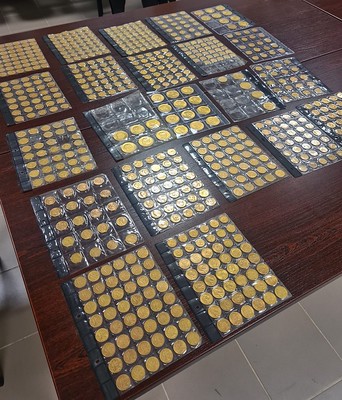 This is the bizarre moment customs officials found a pensioner with close to PLN 1.5 million (€320,000) worth of gold coins hidden inside her clothing.
This is the bizarre moment customs officials found a pensioner with close to PLN 1.5 million (€320,000) worth of gold coins hidden inside her clothing.
Officials discovered the five kilograms of gold coins during a routine search at the border crossing with Ukraine in Hrebenne south east Poland.
According to reports, after being stopped the 68-year-old woman disclosed her secret to the dumbfounded officers before revealing the 670 coins.
Spokeswoman Marzena Siemieniuk said: 661 of the 670 coins examined are foreign exchange gold, which includes, among others, gold coins minted after 1850.
Moreover, some of them are legal tender, i.e. circulation, coins.
FEATURED WEBSITE: CARNATION, LLC
This week's Featured Web Site is Carnation, a maker of currency counting machines.
We are a Chicago-based manufacturer and distributor of currency counters who has been in the business since 2004. People all over the world have recognized the value that Carnation Money Counters delivers. We are currently selling our banknote counters to customers in Canada, Mexico, Europe, Asia, the Middle East, and many other countries around the world.


